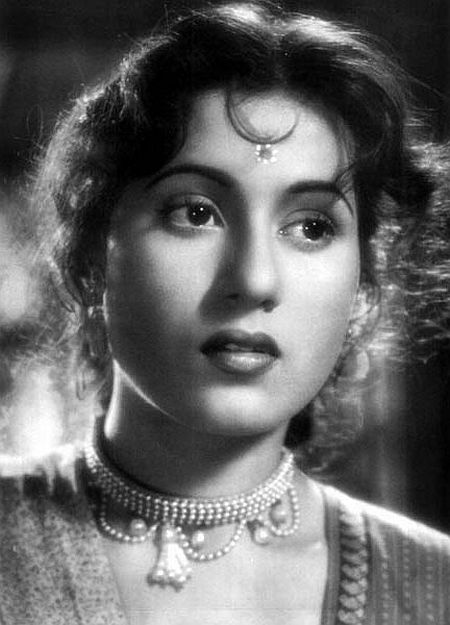A Biography Of Madhubala

From a timid girl of modest origins to the mystical epitome of beauty beyond all comparisons, Madhubala, born as Mumtaz Jahan Begum Dahlavi to a Pashtun couple, was the fifth of eleven children. Her life and works are the objects of research and speculation even today, almost 4 decades after her premature death: such is the prolific influence this belle holds over the minds and imaginations of her admirers and critics alike. She never received a single award, not even for her soul-baring performance in K.Asif's opus magnum 'Mughal-e-Azam', yet she is widely considered beyond doubt to be the one of the most significant artistes that Hindi cinema has produced.
Personal and Professional Life
Madhubala moved to Bombay, now Mumbai, at the tender age of seven when her father lost his job in the Imperial Tobacco Company in Peshawar, Pakistan, and was forced to relocate with his family to make both ends meet. For a year after their resettlement, the family faced severe financial and personal hardships, including the death of some of Madhubala's siblings. This was the time when Madhubala and her father began visiting Bombay Studios looking for jobs. 9-year old Madhubala entered Bollywood as 'Baby Mumtaz' in the 1942 film 'Basant', where her precocious performance was noticed by many. Among them was Devika Rani, who christened her as 'Madhubala'. She went on to work in several other films as a child artiste, and her first big break as the leading lady came in Neel Kamal (1947), where she was cast opposite Raj Kapoor. Over the next few years, she not only established her reputation as an exemplary professional performer, but also cemented her identity as the ideal embodiment of feminine beauty and grace. After the successful 'Mahal' in 1949, she starred in a slew of hits, like Dulari in 1949, Beqasoor in 1950 and Tarana and Badal in 1951. These phenomenal commercial highs were paralleled by the dismal lows of her deteriorating health. She first coughed up blood on the sets of 'Bahut Din Huwe' in 1954. At a ripe 24, this queen of hearts, born on Valentine's Day in 1933, was told that she had a hole in her heart.
Madhubala then starred in several films, working non-stop to support her family financially, often portraying roles that perhaps did not fully challenge her acting abilities, as her contemporaries acknowledged that she was capable of far more. Her stardom saw a decline during the mid-1950s, when her films consistently did poorly, but she gave her image a new lease of life with the hit 'Howrah Bridge', which is emphatically remembered for her sensuous and subtle characterization of an Anglo-Indian cabaret singer, especially in the song 'Aaiye Meherban'. She rose to the new zenith of immortal stardom when she played one half of the star-crossed lovers Salim and Anarkali, in her swan song 'Mughal-e-Azam'. Her relationship with her co-star Dilip Kumar was an intensely speculated facet of her life, and still is today, as hers was a fiercely protected and confidential privacy. She eventually married singer Kishore Kumar.
After the roaring success of 'Mughal-e-Azam', she was offered a plethora of strong lead characters, but her troubling health did not permit her to make full use of this golden period in her career. Her untimely death at the mere age of 36 put a halt to this charismatic lady's myriad talents.
Madhubala as A Screen Legend
Her bespoke delicate loveliness combined with her fantastic acting talent and understated classic elegance lent her a wondrous, larger-than-life aura: unquestioningly, Madhubala has been considered at par with legendary actresses like Greta Garbo, Marilyn Monroe and Audrey Hepburn. She was the reigning empress extraordinaire of Indian cinema, and is still unparalleled in skin and skill. The stature of her fame reached even Hollywood, and she featured in 'Theatre Arts' in a 1952 issue with a full-page portrait and a generous article titled "The Biggest Star In The World (And She's Not In Beverly Hills). Her magnificent carriage on screen and powerful performances that touched the soul, ensured that this timeless beauty remained at the top her trade even in the face of life-threatening health conditions. However, beneath this glamorous exterior was an unassuming person of generosity and innocence, with incredible depth of personality. She was the complete package: beautiful inside and outside.
What makes her the stuff of legends, is the added intrigue of her tragic death, which led to the cessation of what would have been a highly fruitful contribution to the world of cinema. She was called the 'Venus of the Screen' by leading movie magazines of the time, and a commemorative stamp was released by the India Post in 2008. Only 15 films out of the total of 70 films that she starred in during her woefully short lifespan are considered box-office hits, yet her enduring appeal, even today, proves that statistics rarely have anything to do with popularity and like ability, and empiricism is too abstract a concept to be applied to someone of her stature.
That is Madhubala: the seduction of the senses by something other-worldly that leaves a bitter-sweet aftertaste and a lingering fascination, for she is more than an identity, more than a person, more than a character. She is a phenomenon.
Like it on Facebook, Tweet it or share this article on other bookmarking websites.

